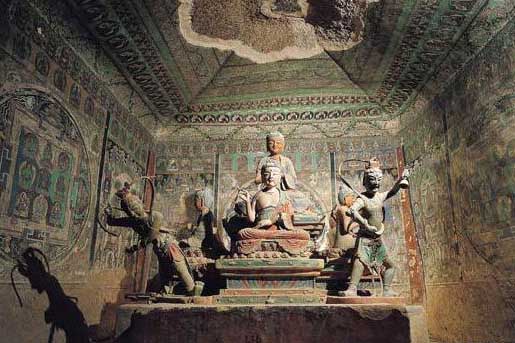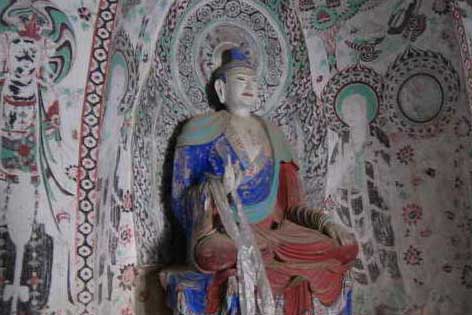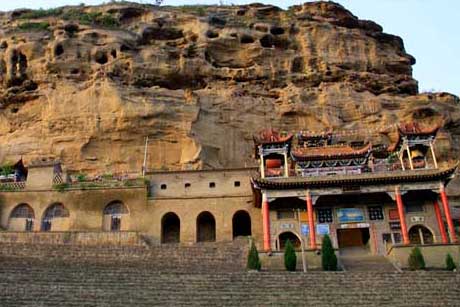Home > Attractions >
Yulin Grottoes
Yulin Grottos ( 榆林窟 ), alias Ten Thousand Buddhas Gorge 万佛峡, lies in a valley 75km to southwest Anxi County 安西县. Anxi County lies at the western end of Hexi Corridor ( 河西走廊 ) and ever to be a famous town on the Silk Road 丝绸之路 as well as an interpretive center for the exchange of economy, culture, politics, diplomacy between Central Plains 中原, and the foreign countries.
Yulin Grottoes is one of the famous caves in China and an essential part of Dunhuang art as well. It was excavated on both sides of the valley in the Northern Dynasty, with 43 caves in total being in actual existence. Though without document reference, it could be founded before Tang Dynasty by judgment from the grotto form and relevant inscriptions. According to the existing mural style and tourist inscription, cutting, painting, and sculpture, as well as large construction, were conducted in all dynasties, including Tang, Five Dynasties, Song, Western Xia, Yuan, and Qing as well as the Republic of China (1919-1949).
Grotto 6 holds 25-m-high Maitreya 弥勒 gilded throughout, brilliant and magnificent as newly built In Grotto 11 are Eighteen Arhats 十八罗汉 with varying looks and vivid expression. Dumb Arhat 哑罗汉, in particular, is set at the western end of the south cliff with leaning upper body as well as wide-open mouth and eyes as a vivid expression hoping to speak but in vain. So it is the best representative of Yulin Grottoes.
The "Central Stupa Shaped Pillar 中央塔柱," "The Vault Top 拱顶" and "Truncated Pyramid Ceiling 截顶" characterize the shape and structure of Yulin Grottoes. Cave 17, 28, and 39 pertains to "Central Stupa-shaped Pillar," i.e., the form and structure of ancient caves in Yulin Grottoes where the original murals had covered by later ones.
The Cave 3 plus Cave 6 pertains to the type of " Vault Top" where the Buddha altar built. The esoteric Tibetan Buddhism 藏传佛教 made much impact on the caves of the Yuan Dynasty, the Central Buddha Altar 中央佛坛 became rounded or octagon in shape in that time except for the square caves there being the same as that of the Tang and Song Dynasties.
The Tang Dynasty was a period of great prosperity in ancient China and for Yulin Grottoes of the day. Not only the specification and quantities but also the artistic value of the caves excavated in that period are unparalleled in history. Cave 25 is representative of them. In the period of the Five Dynasties and the Song Dynasty, the Cao family dominated Guazhou and Shazhou; they established a friendly relationship with both Uyghur 回鹘 Headman and Yutian King 于阗王 by marriage. It resulted in excavating caves and building an imperial art academy on a large scale owing to the steady and prosperous environment in both Guazhou 瓜州 and Shazhou.
Cave 35 is a representative of the day. The caves excavated in the Western Xia Regime and the Yuan Dynasty added new contents, for example, the figure of Kuan-yin gazing at the moon in the water, to the grottoes art.
Both Cave 3 and Cave 4 are representatives of them. Speak of the mural's contents and their style, Yulin Grottoes and Mogao Grottoes had many affinities except for their respective features in form. Yulin Grottoes, the achievement of ancient Chinese, was designated one of the first groups of the critical cultural relics protected by country in 1961.
The Murals in Yulin Grottoes were painted in the 800 years from the Tang Dynasty to the Yuan Dynasty. Some of the images were not seen in other areas, such as the portrait of " Guanzhou Festival Cao's Family (曹氏家族的供养像, Cave 19)", " The Picture of the Painter of the Painting Academy 都勾当画院画家的形象, " "The Image of Shazhou Craftsmen 沙州工匠都勾当画院使保供养像," " The Description of Wu Baolin ( 知画手武保琳供养像, Cave 35 )," " The Portrait of Dangxiang Military Officers in the Western Xia Dynasty 西夏时期党项武官画像 " and " The Picture of Tang Monks Taking Sutras 唐僧取经 " to name just a few. Among them, the Tang murals in Cave 25 are rare treasures in the world.
From August to October, the scenery of Dunhuang is quite beautiful, and the autumn sky is clear, and the air is crisp; during this period, tourists can taste some Dunhuang specialties such as Liguang Apricots and Mingshan red dates and so on.
1. The best way to travel in Guazhoug 瓜州 is to charter a car to visit Yulin Grottoes, Suoyang City 锁阳城 and East Thousand Buddha Caves.
2. Starting from the county town to the town of Suoyang 锁阳, on the way, you will pass an ancient city site, free visit. To the Bajiaoting in the city, the road is divided into two directions, left to Yulin grottoes, right to Suoyang city, and East Thousand Buddha Cave.
3. 67.2km to drive from Guazhou to Yulin caves, about 3 hours.
4. Yulin Grottoes is more than 170 kilometers away from Dunhuang, with excellent road conditions. Self-drivers can drive directly to the scenic area. Moreover, travelers can also take a train or bus from Dunhuang to Guazhou county and then transfer to a taxi.
The Structure of Yulin Grottoes:
Yulin Grottoes were cut in the eastern and western vertical cliffs on both sides of Yulin River Gorge, so named for the elm forest on the banks. It is one of the well-known caves in China. In grotto form, expression contents, and artistic style, it is similar to Dunhuang Mogao Grottoes 敦煌莫高窟. As a branch of Mogao Grottoes Art System and always an attraction to scholars both at home and abroad.The History of Yulin Grottoes:
In the Spring and Autumn Period 春秋时期, Anxi County ( 安西县 ) was called Guazhou 瓜州 where Darouzhi ( people in Central Asia, 大月氏 ) once lived and the Huns 匈奴 Headman once had it under his jurisdiction. It was the popedom of Dunhuang 敦煌 Prefecture in the Han Dynasty 汉代 and divided into Guazhou 瓜州 and Shazhou 沙洲 in the period of Wude of the Tang Dynasty 唐武德时期, of which, Anxi County was called Guazhou 瓜州 and Dunhuang was called Shazhou 沙洲. The Song Dynasty 宋代 called it Guazhou and the Ming Dynasty 明朝 set Handongwei ( i.e., the title of official office ) to manage it as well as the Qing Dynasty 清朝 set Anxi Zhilizhou (i.e., administerial area). Finally, the Republic of China ( 民国 1919-1949 ) named it Anxi County in 1913. In the Han 汉 and the Jin Dynasties 晋, large quantities of persons had immigrated together with advanced techniques and culture of the central plains. The productive forces and the culture there accordingly had been significantly improved; in the meanwhile, the ruling class of the day energetically publicized Buddhism there, action above promoted the development of Buddhism and resulted in the excavation of Buddhist caves.Yulin Grottoes is one of the famous caves in China and an essential part of Dunhuang art as well. It was excavated on both sides of the valley in the Northern Dynasty, with 43 caves in total being in actual existence. Though without document reference, it could be founded before Tang Dynasty by judgment from the grotto form and relevant inscriptions. According to the existing mural style and tourist inscription, cutting, painting, and sculpture, as well as large construction, were conducted in all dynasties, including Tang, Five Dynasties, Song, Western Xia, Yuan, and Qing as well as the Republic of China (1919-1949).
Top Attractions in Yulin Grottoes
Nowadays, there are 43 caves with complete paintings, 32 in the east cliff, and 11 in the west cliff. Two hundred seventy-two colored statues and over 5,650 square meters of the mural are well preserved.Grotto 6 holds 25-m-high Maitreya 弥勒 gilded throughout, brilliant and magnificent as newly built In Grotto 11 are Eighteen Arhats 十八罗汉 with varying looks and vivid expression. Dumb Arhat 哑罗汉, in particular, is set at the western end of the south cliff with leaning upper body as well as wide-open mouth and eyes as a vivid expression hoping to speak but in vain. So it is the best representative of Yulin Grottoes.
The "Central Stupa Shaped Pillar 中央塔柱," "The Vault Top 拱顶" and "Truncated Pyramid Ceiling 截顶" characterize the shape and structure of Yulin Grottoes. Cave 17, 28, and 39 pertains to "Central Stupa-shaped Pillar," i.e., the form and structure of ancient caves in Yulin Grottoes where the original murals had covered by later ones.
The Cave 3 plus Cave 6 pertains to the type of " Vault Top" where the Buddha altar built. The esoteric Tibetan Buddhism 藏传佛教 made much impact on the caves of the Yuan Dynasty, the Central Buddha Altar 中央佛坛 became rounded or octagon in shape in that time except for the square caves there being the same as that of the Tang and Song Dynasties.
The Tang Dynasty was a period of great prosperity in ancient China and for Yulin Grottoes of the day. Not only the specification and quantities but also the artistic value of the caves excavated in that period are unparalleled in history. Cave 25 is representative of them. In the period of the Five Dynasties and the Song Dynasty, the Cao family dominated Guazhou and Shazhou; they established a friendly relationship with both Uyghur 回鹘 Headman and Yutian King 于阗王 by marriage. It resulted in excavating caves and building an imperial art academy on a large scale owing to the steady and prosperous environment in both Guazhou 瓜州 and Shazhou.
Cave 35 is a representative of the day. The caves excavated in the Western Xia Regime and the Yuan Dynasty added new contents, for example, the figure of Kuan-yin gazing at the moon in the water, to the grottoes art.
Both Cave 3 and Cave 4 are representatives of them. Speak of the mural's contents and their style, Yulin Grottoes and Mogao Grottoes had many affinities except for their respective features in form. Yulin Grottoes, the achievement of ancient Chinese, was designated one of the first groups of the critical cultural relics protected by country in 1961.
Opening Hours & Admission Fee
| Opening Hours |
Peak season: 1st May - 15th October ( 9:00 - 17:30, 16:30 stop entering the scenic spot )
Off-season: 16th October - 30th April ( 10:00 - 17:00, 16:00 stop entering the scenic spot ).
|
| Admission Fee | CNY 55 |
| Recommended For a Visit | 1 - 3 Hours |
The Murals in Yulin Grottoes:
The Murals in Yulin Grottoes were painted in the 800 years from the Tang Dynasty to the Yuan Dynasty. Some of the images were not seen in other areas, such as the portrait of " Guanzhou Festival Cao's Family (曹氏家族的供养像, Cave 19)", " The Picture of the Painter of the Painting Academy 都勾当画院画家的形象, " "The Image of Shazhou Craftsmen 沙州工匠都勾当画院使保供养像," " The Description of Wu Baolin ( 知画手武保琳供养像, Cave 35 )," " The Portrait of Dangxiang Military Officers in the Western Xia Dynasty 西夏时期党项武官画像 " and " The Picture of Tang Monks Taking Sutras 唐僧取经 " to name just a few. Among them, the Tang murals in Cave 25 are rare treasures in the world.Tales of Sutras of Samantabhadra 普贤经故事:
Arts and culture in Western Xia regime diversified with high achievement in painting, calligraphy, sculpture, dancing, and music In the Picture, Buddhist painting has passed down to today, existing in grottoes, temple murals among others, most abundant in Yulin Grottoes, Guazhou 瓜州. In the early Northern Song Dynasty, influenced by Uygur mural art and Tibetan Buddhism, it finally formed a unique artistic style; its unique artistic style was influence by Uyghur and Tibetan Buddhism. The lines took the methods of Tiexian (Iron Line, 铁线 ) and Lanyemiao (orchid-leave line drawing, 兰叶苗 ) and Zhelu (broken reed) plus Chuncaitiao (water shield thread) as support; Fucai (color applying) takes a large number of metallic green as the background color, which makes the picture become a green mural with "fresh color," which covered the Buddhist story and preach. The Bodhisattva 菩萨 worship, human figures, grotto decoration designs, etc., of which Tales of Sutras of Samantabhadra as the most well-known.Pilgrimage of the Tang Priest for Buddhist Scriptures:
The Western Xia and Yuan murals of Yulin Grottoes are distinctive in subject matter and style, Influenced by Esoteric Buddhism 密宗, some subject matters emerged, including Water and Moon Avalokitesvara 水月观音, Vajrayana Stramonium 金刚乘 and others rare in the preceding dynasties. Two paintings on Pilgrimage of the Tang Priest for Buddhist Scriptures, in particular, are drawn in Cave 2 and 3 in murals of Western Xia Regime, which created over 300 years earlier than the novel in Ming Dynasty, Pilgrimage to the West, as indeed an excellent work for all ages. In the figure, the painting appears Western Xia and Mongolian persons exceptional in clothes and looks. Therefore, the Western Xia and Yuan murals may more clearly reflect the character interaction and competition of the artistic traditions of an ethnic group with Western Xia, Mongolia, and other ethnic groups. Here, Yulin Grottoes can make up for the shortcoming of Mogao Grottoes.Climate and Weather Yulin Grottoes
Every May to October is the best time to travel to Yulin Grottoes. Dunhuang belongs to arid continental climate zone, it is dry and rainless all year round, the temperature of Dunhuang is the difference between day and night, and the highest temperature in summer can reach 40 degrees Celsius.From August to October, the scenery of Dunhuang is quite beautiful, and the autumn sky is clear, and the air is crisp; during this period, tourists can taste some Dunhuang specialties such as Liguang Apricots and Mingshan red dates and so on.
Annual Temperature of the Year/℃ ( High-Low )
| Jan. | Feb. | Mar. | Apr. | May. | Jun. |
| -12/-22 | -9/-20 | -8/17 | 15/1 | 19/7 | 25/12 |
| Jul. | Aug. | Sept. | Oct. | Nov. | Dec. |
| 27/16 | 26/15 | 19/5 | 9/-2 | -1/-12 | -10/-21 |
How to Get to Yulin Grottoes:
1. The best way to travel in Guazhoug 瓜州 is to charter a car to visit Yulin Grottoes, Suoyang City 锁阳城 and East Thousand Buddha Caves.2. Starting from the county town to the town of Suoyang 锁阳, on the way, you will pass an ancient city site, free visit. To the Bajiaoting in the city, the road is divided into two directions, left to Yulin grottoes, right to Suoyang city, and East Thousand Buddha Cave.
3. 67.2km to drive from Guazhou to Yulin caves, about 3 hours.
4. Yulin Grottoes is more than 170 kilometers away from Dunhuang, with excellent road conditions. Self-drivers can drive directly to the scenic area. Moreover, travelers can also take a train or bus from Dunhuang to Guazhou county and then transfer to a taxi.






